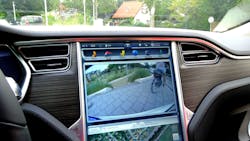An automotive industry group is doubling down on the idea of standard software that lets companies mix and match embedded processors in cars. The group is taking concept behind Autosar, a standard that defines basic software functionality for airbag systems and windshield wipers, and applying it to autonomous driving.
The Autosar partnership completed the new branch of the standard, called the Adaptive Platform, last month after two years of development. It’s not a replacement for classic Autosar, which stands for the Automotive Open System Architecture and started as a way to standardize software in electronics control units for maximum reusability.
Both standards show that the hundreds of embedded processors and miles of wiring inside cars are growing impractically complex. To enable applications like adaptive cruise control and lane departure warnings, cars are handling more data and having to move it faster than ever. Intel estimates that a fully autonomous car will generate 4 terabytes of data in an hour and half of driving.
In most vehicles, embedded software is coupled tightly with electronic control units. But Autosar, which started out almost fifteen years ago, introduced a buffer between those parts. With it, suppliers can transfer basic software functionality between vehicles and automakers, reducing the time and complexity that had plagued software development for years.
“If you go back to this era, the communications between Tier One suppliers and OEMs happened through pdf documents,” said Sherif Ali, a systems architect with Mentor Automotive, referring to past attempts at software reusability. “There was no real standard to this exchange,” he added.
Autosar is an attempt at changing that. Automotive suppliers can swap out the basic software between vehicle systems – like an air conditioning unit for General Motors and a windshield wiper system for Ford – freeing engineers to tweak the specific application. The Autosar specification includes drivers for operating sensors and can also automatically generate code.
Many automakers think this could be helpful for cars with dashboard displays, vehicle-to-vehicle communications, cameras and other sensors streaming data about the car’s surroundings. The modules governing these systems need to interact quickly to provide advanced driver assisted systems, which cannot always be handled by dedicated processors.
“Currently, vehicles have very static vehicle architectures where brake and steering modules send a lot of messages to nodes that know who and where all the units are,” Alexander Much, head of automotive software systems engineering at Elektrobit, tells the Society of Automotive Engineers last year.
"Now, more dynamic things are coming, where nodes don’t need to know where computers they are communicating with are located or when they’re going to transmit,” Much added. To that end, the new standard will support faster service-oriented communications over Ethernet.
The Adaptive Platform will also support over-the-air software updates for multicore processors that handle driving decisions too complex for simple microcontrollers. It will also aid software development for infotainment, allowing companies to integrate operating systems into dashboard displays.
Other features offer flexibility for coding pathways between electronic control units. They include programs for situational startup and shutdown of applications, remote patches, and software diagnostics. The standard also smooths out communications between systems using classic Autosar or proprietary code.
It’s too soon to predict the Adaptive Platform’s success, but the automotive industry is not writing off the broader benefits of standards. As far back as 2013, researchers at BMW’s information technology unit called for standards to ensure that the complexity of autonomous driving – with huge computing requirements – would not undercut reliability or safety.
The platform will also need to strike a balance between the expediency of using a standard and automakers’ demand to customize their software and drive competition. But in the short term, the Adaptive Platform could also feed off the growth of traditional Autosar.
In recent years, the standard’s center of gravity has slowly spread out from Europe, where most Autosar software suppliers are based. Among the companies that founded the Autosar consortium in 2003 are Continental, Daimler, Volkswagen, BMW, and Bosch. Toyota and Peugeot Citroen Automobiles are also core members.
General Motors, which jumped onboard in 2004, is using Autosar for basic software functionality in its electronic control units. Ford and Fiat Chrysler – which has also partnered with Google’s autonomous driving unit Waymo – are close behind. The three companies founded the North American Autosar user group in late 2015.
Improvements to the Adaptive Platform standard will be released every six to nine months. Several features for debugging and backtracking of software errors, hardware acceleration to drive parallel computing, and a platform for monitoring the integrity of the platform are already in development.
Some engineers say that embedded software standards are vital for hitting the moving target of fully autonomous driving, which is still a long ways off. “We need adaptive applications so that we can fundamentally change the software during the lifetime of the vehicle,” said Mentor Graphics’ Ali.


